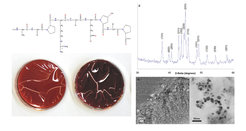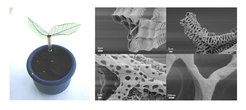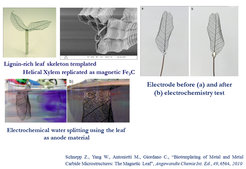Biopolymer template nanoparticles
Metal nitrides and carbides (e.g. Fe3C, Fe3N) show numerous unique properties not accessible through their more well-known oxide counterparts. However, the synthesis of phase-pure and morphologically defined nitrides and carbides offers significant challenges. We have developed new routes to binary and ternary metal carbides and nitrides through the control of nucleation and growth of the intermediate ceramic phases. By dispersing aqueous metal salts within a biopolymer matrix, the nucleation of these intermediate precursors (often an oxide phase) is constrained to the nanoscale. On further heating, the carbon or nitrogen-rich decomposition products of the biopolymer react with these oxide nanoparticles, forming carbide or nitride nanoparticles. In this way, simple and readily-available starting materials can be used to produce a wide range of structurally and compositionally complex products.

Images show a typical structure of the gelatin biopolymer, films of gelatin containing iron salts, an XRD and corresponding SEM and TEM images of Fe3C nanoparticles synthesized by calcining the Fe-gelatin films to 650°C.
Bio-templating of metal carbides
By coating a biological template with aqueous metal precursors, the complex microstructure can be replicated as metal carbide. In this work, we replicated the hierarchical structure of leaf veins with the magnetic material Fe3C.




